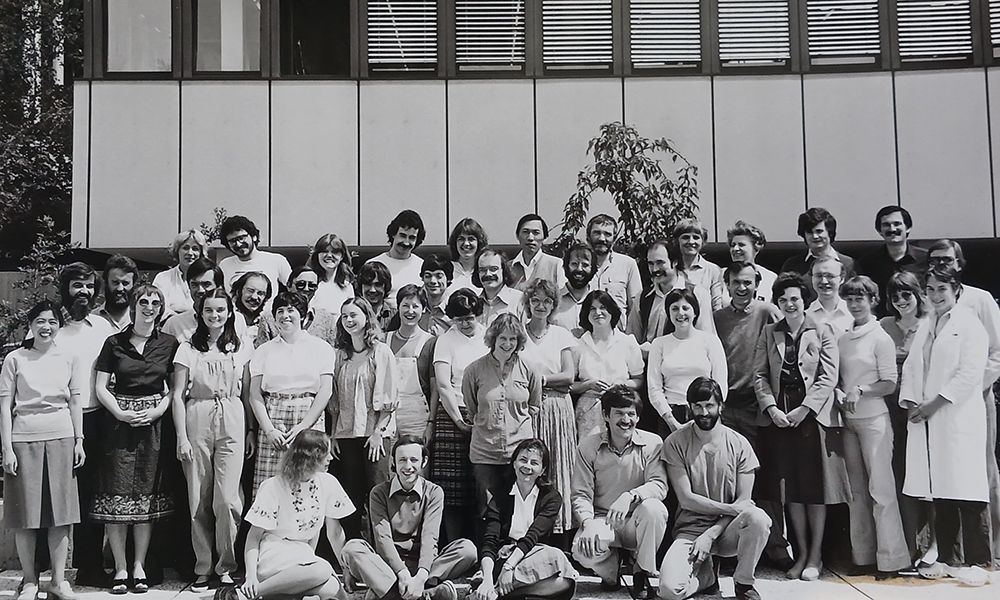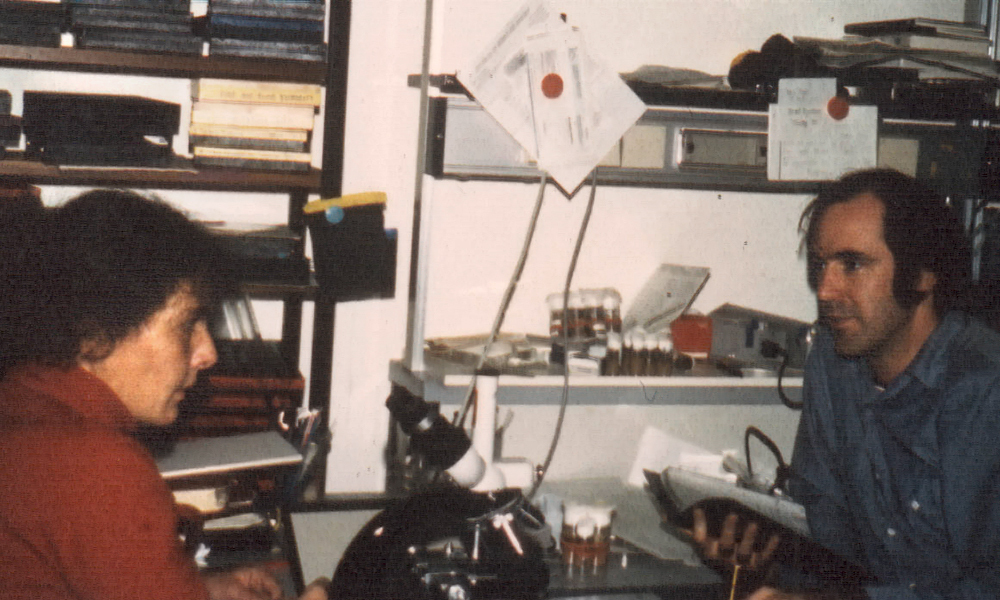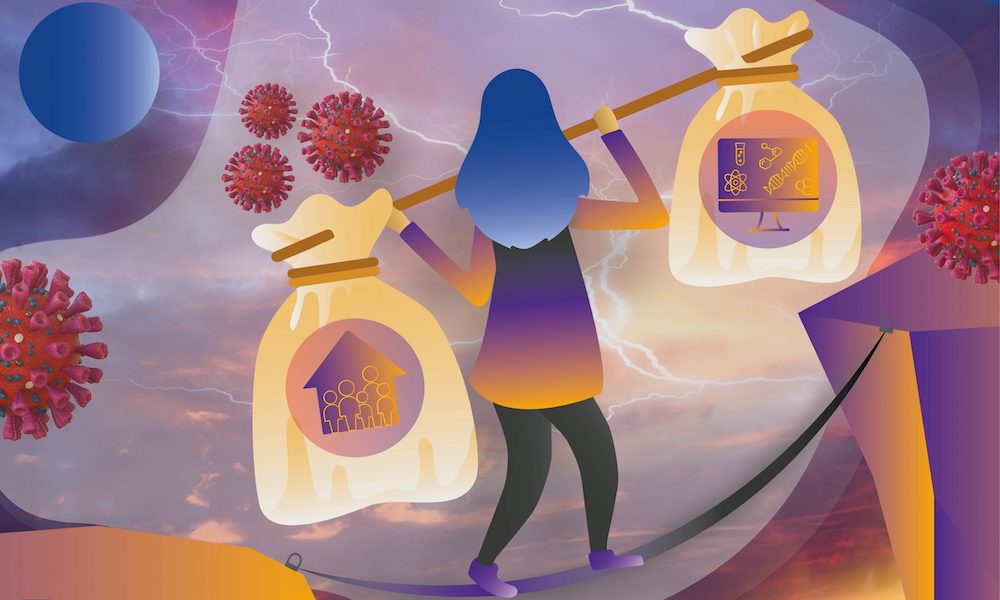
Tracing the history of women in science at EMBL
On the occasion of International Women’s Day 2023, EMBL archivist Maria Papanikolaou discusses the traces left by the women in science who have passed through EMBL, irrevocably changing the organisation in small and big ways

By Maria Papanikolaou, Archive and Records Manager, EMBL
The EMBL Archive’s mission is to capture, manage, preserve, and make accessible EMBL’s history, heritage, and institutional memory. In addition to studying the organisation’s macrohistory – legal framework, institutional development, scientific history etc., the archives also aim to capture its microhistory – the story of its people.
Currently, the EMBL Archive runs up against a gap when it comes to microhistory pertaining to women in science. Beyond the notable exception of Christiane Nüsslein-Volhard, who in 1995 won the Nobel Prize alongside Eric Wieschaus for their work at EMBL during 1979-1980, there were few women in the limelight in the first decades of EMBL’s existence. While the archives document the stories of EMBL’s “founding fathers” and many of EMBL’s prominent male scientists and administrators, presently it contains only two major collections about prominent female scientists. These focus on Mumna Al Banchaabouchi, who was the Head of the Phenotyping Facility at EMBL Rome from 2004 to 2012, and Claire O’Donovan, Head of Metabolomics at EMBL-EBI. This relative lack of information on women scientists in the archives reflects general worldwide trends that show women are still underrepresented in science.
However, upon studying the available EMBL archival sources beyond what is obvious, we can discover traces and moments of women’s experience at EMBL throughout its history. These traces, consisting of oral histories, pictures, posters, and institutional publications, tell a story of oft-hidden achievements and contributions by women to the development of EMBL.
For the past decade and more, EMBL has reaffirmed its commitment to improving gender parity in science and the recent appointment of Edith Heard as EMBL’s first female Director General in 2019 is a testament to how far we have come. An important step was the formation of the Gender Balance working group, initiated and chaired by Anne Ephrussi, former head of the Developmental Biology Unit at EMBL, one of EMBL’s first women group leaders, and Director of EMBL International Centre for Advanced Training (EICAT). Building on work from this group and subsequently the Equality, Diversity and Inclusion (EDI) committee, the EDI office was established in 2021.
In 2022, the EDI office released its first comprehensive Gender Equality Plan. In addition to trying to redress the underrepresentation of women in leadership roles in science, the plan hopes to “ensure that women feel included, thrive, and develop a strong sense of belonging at EMBL”. One of the initiatives supported by this is LEAP – Leadership and Excellence for Aspiring Postdocs, enabled by philanthropic contributions from Friends of EMBL and Eppendorf SE as well as EMBL Alumni, who volunteered as mentors. This mentorship programme provides advanced training, 1:1 coaching, and external mentorship to women post-doctoral fellows to support them in transitioning into their next career step as group leaders and principal investigators.
“These are exciting times for EDI at EMBL and I’m really heartened to see the huge progress we have made,” said Eileen Furlong, Head of the Genome Biology Unit at EMBL Heidelberg. “It’s invigorating to work with such a diversity of colleagues, who have such a strong sense of social justice and who are prepared to put in the hard work required to bring about change.”
The initiatives noted above and other ongoing efforts draw from a long history of open discussion and concerted efforts towards levelling the playing field when it comes to science at EMBL.
Early inroads
Some of the earliest women group leaders at EMBL were Brigitte Jockusch and Marialuisa Melli, who both joined EMBL Heidelberg in 1978. Among administrative units, some of the earliest women on staff at EMBL were Frieda Glöckner, Head of Council Secretariat, joining in 1970, and Mary Holmes, who took up the role of Librarian in 1974. Glöckner, who was involved in drawing up EMBL’s very first indicative scheme, stayed with the institute for 37 years before retiring in 2006. Holmes, likewise, stayed with EMBL for 24 years, managing the Szilard Library till 1998.
The first archival traces of women’s experience at EMBL can be identified in the late 1980s, when the first childcare centre was opened at EMBL – today’s EMBL Kindergarten. This came on the heels of a realisation that, as described in EMBL Twenty Years On, 1974-1994, family responsibilities “are often felt most strongly by women scientists, who are not only trying to make headway in a discipline traditionally dominated by men but who, despite modern trends, still often bear the greater burden for care of children”. Thomas Graf, one of the group leaders behind the initiative, remarked that the childcare facilities “would make it easier for women to develop an independent career”.
The next well-documented moment in the history of women at EMBL was the awarding of the Nobel Prize for Medicine to Christiane Nüsslein-Volhard and Eric Wieschaus in 1995, for the first systematic genetic analysis of embryonic development in the fruit fly. Nüsslein-Volhard and Wieschaus conducted this seminal research at EMBL during 1978-1980, sharing a single tiny lab. In later years, Nüsslein-Volhard supported EMBL as a member of the Scientific Advisory Committee (SAC). In 2003, she established the Christiane Nüsslein-Volhard Foundation, which supports women scientists with funds for childcare and cleaning services.

Creating an inclusive environment
With the advent of the 21st century, EMBL and EMBO initiated a number of activities for supporting and empowering women in science. In June 2001, EMBO’s meeting ‘The Glass Ceiling for Women in the Life Sciences’ was held at EMBL Heidelberg. In the meeting, it was pointed out that the “incompatibility” of being a career researcher and bringing up a family was one of the main reasons for the continued marginalisation of women in science.
After the meeting, EMBO started a fellowship programme for women scientists who had taken a break in their careers for childcare and wished to return to science. This initiative was followed by others, like Girls Day at EMBL, ambassador’s programmes for schools and universities, and projects like SET-Route – a project coordinated by EMBL, EMBO and CERN to mobilise women in science, engineering, and technology and encourage students to pursue a career in science. A commitment to “reasonable gender balance” was also mentioned prominently in the EMBL Strategic Forward Look 2006-2015.
Empowering women in leadership roles
During the early 2000s, more women took their place in crucial leadership positions at EMBL. Two notable appointments were Nadia Rosenthal as the Head of the newly established Mouse Biology Programme in Monterotondo, and Janet Thornton as the Director of EMBL-EBI in Hinxton.
Janet Thornton shared her testimony with the EMBL Archive as part of its oral histories after the end of her fourteen-year-long tenure (2001-2015) as EMBL-EBI Director. She mentioned how when she joined EMBL-EBI, “almost all PIs were male with very few senior female voices”, and that bioinformatics was a “pretty male-dominated culture” in comparison with the field of structural biology, “where women crystallographers, such as Dorothy Hodgkin, were key players in the field”. She also mentioned how important active encouragement is for women in science when it comes to leadership positions: “I would not have applied for the Director job unless I had been asked. So, just by encouraging personally individuals to apply, I think that helped us very much to improve the situation.”
Since 2010, women have been continuously appointed to the highest leadership positions at both EMBL and EMBO: Edith Heard as the first female EMBL Director General in 2019, Maria Leptin as the first female EMBO Director in 2010, followed by Fiona Watt in 2022. Last year also saw the appointment of Kristina Djinović-Carugo as the next Head of EMBL Grenoble. Two other women who have exemplified women’s excellence in leadership roles are Anne Ephrussi, who became the Head of EMBL’s Developmental Biology Unit in 2007 and the Head of EMBL International Centre for Advanced Training in 2005, and Jo McEntyre, who was appointed Associate Director of EMBL-EBI Services in 2019.
Since her appointment, Heard has also surrounded herself with an increasingly female and geographically diverse leadership team. Notable hires include Jessica Vamathevan, Head of Strategy, Plamena Markova, Head of International Relations, Rachel Curran, Deputy Chief Operating Officer, and Sihem Bennour, Head of Human Resources. In addition to conferring visibility to women’s role at EMBL, these appointments reconfirm EMBL’s commitment to breaking free of stereotypes.
Looking ahead

With the advent of the pandemic, it became quickly clear that women scientists were bearing a disproportionate level of the ensuing burden. In September 2020, EMBL organised a virtual conference on ‘The impact of the COVID-19 crisis on women in science’. Featuring speakers from across the world, the conference highlighted how the pandemic has “magnified systemic gender inequalities and conspicuous injustices” and discussed practical steps, solutions, and actions to improve gender parity as part of the “new normal”.
In October of the same year, EMBL, EMBO, and the Howard Hughes Medical Institute co-organised the conference ‘Gender Roles and their Impact in Academia’. The conference focussed on how the progression of men and women in academic and related careers is influenced by the linkages between biology, society, and gender roles, as well as how this understanding can be used to help everyone enjoy equal opportunities in work and academic advancement. This and other such events continue to explore the evolving gender dynamics in science and brainstorm solutions to systemic imbalances.
The story of women in science at EMBL as told in its archives has many pieces: prevailing stereotypes at the time, challenges related to the disproportionate share of parenting, housework, and caregiving responsibilities that women are often expected to take on, their many achievements, the importance of inclusion, and growing recognition of women in leadership roles. The next chapter in this story will be written as the next generation of women in science flourishes and grows, and the goal for the organisation would be to build confidence, competency, and self-awareness, helping women succeed despite restrictive societal attitudes. In this, these fierce women will be following in the footsteps of Christiane Nüsslein-Volhard, who once said, “I had realized that my strength was to develop strategies to do things that other people think are impossible to do in a reasonable way.”
Further Reading
- Watts R (2007). Women in Science, A Social and Cultural History, 1st ed. Routledge.
- Fisher A and Henningsen K (2017). Women in Science through an Archival Lens. Transformations: The Journal of Inclusive Scholarship and Pedagogy 27 (2) 158–79.


